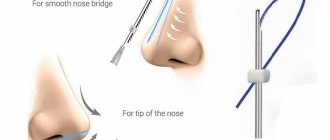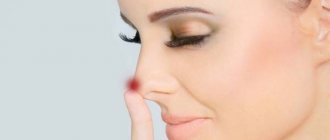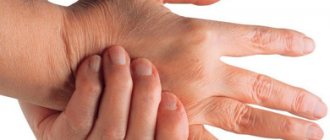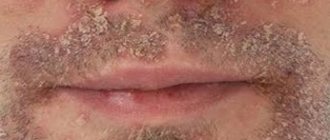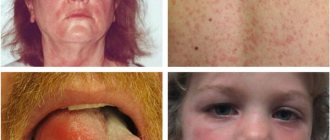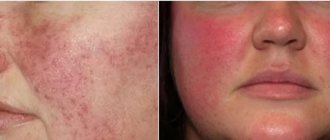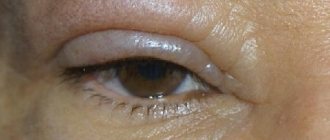- Published by: Laima Jansons
All causes and factors for the appearance of red spots on the nose can be divided into two groups - local and general .
The first group includes phenomena that provoke a rush of blood to the face , peeling, drying of the skin, irritation or hypothermia.
Common causes must be sought within; they only appear on the face, but the root of the problem lies much deeper. Since the skin is an indicator of internal processes, the location of the red spots can tell in which organ the disorder is occurring.
Red spots on the tip of the nose appear quite often and can be single or multiple , appearing on other parts of the face.
Symptoms of rosacea
The clinical manifestations of the disease differ depending on its form. But in most cases, rosacea is accompanied by the following symptoms:
- Erythema. Redness of the skin in the central part of the face. Initially, it is episodic in nature, but over time the frequency of occurrence increases. The shade can vary from bright pink to bluish.
- Increased dryness of the skin, excessive sensitivity to touch. In some cases, mild pain or a tingling sensation may occur.
- Telangiectasia. The so-called spider veins. They are dilated capillary vessels that look like small spots and nets of pink or red color. Most often located around the wings of the nose.
- Papules. Dense skin nodules that rise slightly above the surrounding skin. The color is flesh or pale pink. When there are large numbers, they can merge into one common bumpy surface.
- Pustules. Small bubbles filled with clear or slightly cloudy liquid. Formed in place of papules.
- Structural changes in the skin. Initially, swelling of the affected areas occurs, which can subsequently be combined with hyperplasia (thickening) of the skin. In some cases, large structural formations form that distort facial features.
- Eye lesions. Redness of the mucous membranes, often combined with itching and a feeling of “sand” in the eyes. In severe cases, crusts appear at the roots of the eyelashes, and visual acuity decreases.
Erythema with rosacea.
Photo: Head & face medicine / Open-i (CC BY 2.0) Rosacea is characterized by periods of exacerbations and remissions. During exacerbations, new elements of the rash (papules, pustules) appear. When going into remission, the rash often disappears, but skin erythema, telangiectasia and structural changes in the facial skin persist.
Rhinophyma (inflammation of the skin of the nose)
is an inflammation of the skin of the nose due to the proliferation of connective tissue, blood vessels and sebaceous glands, which leads to disfigurement of the nose (wine nose, pineal nose). It can occur as a benign tumor formation.
Symptoms of rhinophyma
The disease develops gradually - it begins with itching, flaking and slight redness of the skin of the nose. Then tubercles form, the skin thickens, soreness, a bluish color, spider veins appear, the nose loses its normal shape, grows, becomes disfigured, and the resulting formations can interfere with breathing, reducing the quality of life.
Have you noticed the following symptoms? Make an appointment
Forms of the disease
Rhinophyma is distinguished by the form of manifestation of the disease:
- in the fibrous-angiomatous form, the size of the nose is uniformly increased, the color of the nose is copper-red or purplish-red, veins are clearly visible, small cavities with blood-purulent contents are observed, which subsequently turn into crusts.
- with the granular (glandular) form, cluster-shaped formations on the nose of a bluish-red color are observed, which close the nostrils and mouth, disfigure the person’s face, and make breathing and eating difficult.
- with the fibrous form of rhinophyma, a finely lumpy appearance of the nose is noted, while the skin is smooth and bluish-violet.
- with the actinic form of rhinophyma, a uniform enlargement of the nose occurs with the expansion of spider veins and capillaries on the wings of the nose.
Causes of the disease
Rhinophyma may be caused by demodex, a microscopic skin mite. In addition, the causes may be skin diseases that are inflammatory and chronic in nature, such as rosacea and acne.
The development of the disease is facilitated by hypothermia or prolonged exposure to the sun, alcohol abuse, chronic diseases of the gastrointestinal tract and endocrine system, and autoimmune diseases.
Diagnostics
Diagnosis is based on an examination by an ENT doctor, a dermatologist and sometimes an oncologist. In some cases, a biopsy is indicated to exclude a malignant process. The specialist identifies the cause of rhinophyma, takes a scraping for demodex, and, if necessary, examines hormonal levels and the gastrointestinal tract. General blood tests, biochemical tests, as well as for the presence of parasites and infections are taken.
We recommend that you consult a doctor! 276-00-15
Treatment of rhinophyma
Treatment is aimed at eliminating the aesthetic problem and restoring normal nasal function. In the initial stages, local hormone therapy, drugs that improve blood microcirculation, drugs that improve digestive function are used, and if necessary, hormonal levels are adjusted.
As the disease progresses, surgical treatment using surgical laser and radio wave surgery is used. Under local anesthesia or endotracheal anesthesia, hypertrophied areas of skin are removed, creating a wound surface that is covered with a skin scab after 10-12 days. After the surface is cleansed, the skin looks reddened, but over time it acquires its normal color.
doctor
In more advanced cases, plastic surgery is performed with wedge-shaped excision of the affected connective tissue, tissue transplantation and suturing.
Rosacea treatment
Since rosacea is currently an incurable pathology, the main goals of therapy are:
- Suppressing existing symptoms and improving the overall condition of the skin.
- Slowing down further progression of the disease.
- Prevention of repeated exacerbations and complications.
- Elimination or minimization of cosmetic defects.
To achieve these goals, various means are used: drug therapy, physiotherapy, and, if necessary, surgery. Moreover, the effectiveness of treatment depends on the duration of the disease, the severity of the clinical form and the presence of concomitant pathologies.
How to care for facial skin with rosacea
Rosacea requires special skin care. It is based on the following principles:
- Cleansing the skin should be soft and gentle, without using hot water, as it dilates blood vessels.
- Vacuum massage, frequent peelings, and facial steaming are contraindicated.
- When choosing cosmetics, you should choose products without alcohol and detergents. In this case, you should give preference to products that contain components that strengthen the vascular wall: vitamins K, P, C, ambophenol.
- When staying in the sun or in the cold, be sure to use a protective cream, and then a nourishing one.
- When washing off cosmetics, it is better to give preference to clean water.
Drug therapy
The leading place in the treatment of rosacea is occupied by medications. Most often, the therapeutic regimen includes:
- Systemic antibiotics. For oral administration, tetracyclines (doxycycline, tetracycline), macrolides (azithromycin, clarithromycin), and antimicrobial agents (metronidazole) are prescribed.
- Systemic retinoids. Drugs in this group are structural analogues of vitamin A. Their use is recommended for severe rosacea (in modern clinical practice, isotretinoin is most often used).
- Local therapy. For application directly to the affected areas of the skin, metronidazole, azelaic acid, sodium sulfacetamide, and clindamycin are prescribed.
- Angioprotectors. To improve the condition of blood vessels, xanthinol nicotinate, belladonna alkaloids, and ergotamine are used.
- Additional funds. For ophthalmic rosacea, artificial tears may also be prescribed. After eliminating the active inflammatory process, brimonidine therapy is possible to combat erythema.
Physiotherapeutic procedures
Physiotherapy is an important part of complex treatment, complementing the effect of medications. For rosacea, the following procedures are most often prescribed:
- Cryotherapy and cryomassage.
- Electrocoagulation.
- Laser therapy.
- Selective pulsed phototherapy.
- Microcurrent therapy.
- Endonasal electrophoresis.
- Dermabrasion.
Surgery
When excess tissue forms on the face (for example, with phymatous and granulation variants of rosacea), its removal is indicated. This can be done in various ways: ablative lasers (CO² lasers or erbium YAG laser), cryosurgery, plastic surgery, electrocoagulation, etc.
Rosacea: before and after treatment. Photo: American Academy of Dermatology / ResearchGate (Creative Commons Attribution-NonCommercial-NoDerivatives 4.0 International)
3. Symptoms and diagnosis
As shown above, typical manifestations of erysipelas of the nose include erythema and inflammatory swelling of the soft tissues, clearly demarcated by a roller from healthy skin. The swelling can be so severe that the patient’s face becomes deformed and changes beyond recognition. Blisters filled with mucopurulent exudate (bullous form of erysipelas) are often observed.
As a rule, the general symptoms of infectious intoxication are pronounced: malaise, fever, hyperthermia (up to 40° and above), headache, weakness, soreness and swelling of the nearest lymph nodes. After a few days, body temperature may drop just as sharply.
It should be noted that in the absence of timely adequate therapy, erysipelas tends to expand to neighboring areas (skin of the face, neck, chest, ear, etc.); with the involvement of the mucous membranes and submucosal layers of the pharyngeal structures, the development of such serious complications as abscess formation, phlegmon, sepsis, and intracranial inflammation is possible.
The clinical picture of erysipelas is quite specific and usually does not create any difficulties in diagnosis. Examination of the ENT organs reveals hyperemia of the mucous membranes of the nasal cavity. Laboratory diagnostic methods are used to identify the pathogen(s) and assess drug sensitivity. In more complex cases, they resort to instrumental imaging diagnostics (endoscopy, ultrasound, etc.).
About our clinic Chistye Prudy metro station Medintercom page!
Causes of the disease
At the moment, the exact causes of rosacea have not been established.
It is believed that from 15% to 40% of all cases of the disease are associated with a hereditary tendency to this pathology.
A number of factors lead to the development of rosacea, among which the following play the most important role:
- Violation of vascular tone. This is often manifested by migraines and a tendency to spontaneous redness of the face (transient hyperemia).
- Lymphostasis, lymph stagnation. Accompanied by tissue swelling.
- Hormonal imbalance. The cause of rosacea can be both physiological fluctuations in hormones in the body (changes in the menstrual cycle, pregnancy, transition to menopause) and endocrine diseases, such as pathologies of the thyroid gland.
- Skin diseases. Rosacea is associated with disruption of the sebaceous and sweat glands, including seborrhea. Its development can also be provoked by demodicosis (infection of the skin with parasitic mites - Demodex folliculorum).
- Diseases of the gastrointestinal tract and digestive disorders. Triggering factors can be Helicobacter pylori infection, gastritis, duodenitis, colitis. Errors in nutrition also play an important role, including excessive consumption of spicy and fried foods.
- Stress. There is an opinion that nervous overstrain can trigger the onset of the disease.
- Immune system dysfunction: HIV infection, AIDS, diabetes mellitus.
- Excessive exposure to ultraviolet rays. Skin lesions can be associated with excessive tanning and sunburn, and abuse of solariums.
- Occupational hazards. In some cases, the trigger (trigger factor) may be working conditions: working in the open air, in cold or hot weather, in strong winds. Rosacea can also develop when the skin comes into contact with chemicals used in manufacturing.
- Side effects of medications. Rosacea can occur as a reaction to medications (often bromine and iodine derivatives). It is also associated with long-term, uncontrolled use of oral or topical hormonal drugs, such as oral contraceptives or corticosteroid ointments.
- Incorrect use of cosmetics. A trigger for rosacea can be the application of low-quality cosmetics to the skin of the face, which contain chemical irritants.
Patients with rosacea often suffer from nervous system disorders. Photo: wirestock/freepik.com
Risk factors
In addition to disorders that can directly cause the development of rosacea, it is worth mentioning factors that do not independently provoke the disease, but increase the risk of its occurrence. These include³:
- Female. Women are more likely to develop rosacea than men.
- Fair skin, especially those with high sensitivity to the sun. This is manifested by frequent sunburn even after short periods of exposure to direct sunlight.
- Age over 30 years.
- Smoking.
- The presence of rosacea in close blood relatives.
Why red spots don't go away
Red, swollen spots on the tip and sides of the nose can be a constant occurrence, disappearing for several hours or days and appearing again.
Constant exposure to allergens
Any allergen can be a potential irritant; an allergist will help identify it by conducting the necessary research . Associated symptoms, lacrimation, rash on the face, and burning of the mucous membrane may indicate an allergy .
Demodicosis
This is the most common cause of spots on the tip of the nose and in the mouth area. Demodex are mites that can be found in feather pillows. Treatment for this disease is usually long and complex . Almost every person has the parasite, the causative agent of demodicosis, but if symptoms of its infection appear, this indicates a decrease in the body’s defenses, therefore treatment is primarily aimed at strengthening the immune system and eliminating risk factors .
Frequent weather changes
In some cases , a “cold allergy” can be observed; this is not dangerous and the symptoms gradually go away on their own . You can protect your nose with high-quality nourishing creams, which should be applied before leaving the house in cold weather.
Fungal infection
Rash and spots on the nose with accompanying itching may indicate the development of candidiasis. In this case , the skin will peel and itch , and then you need to consult a dermatologist.
Frequent worries and stress
The skin instantly reacts to changes in lifestyle . A stressful situation can be not only an incident that caused a strong shock, but also a change in climatic conditions, nutrition, or taking certain medications.
Complications of rosacea
Rosacea can lead to various complications, both infectious and cosmetic. The most common are:
- Purulent-septic complications. This includes all types of skin lesions associated with secondary infection, most often with pathogenic bacteria. One of these is the draining sinus. It is a long-term, sluggish inflammation, accompanied by the formation of an oval skin formation, from which purulent masses are constantly released.
- Eye lesions. Long-lasting inflammatory reactions of the tissues of the eye and eyelid against the background of ophthalmic rosacea can lead to deterioration of vision. In severe cases, even its complete loss - blindness - is possible.
- Gross cosmetic defects. Long-term course of rosacea, especially with its phymatous and granulomatous variants, often leads to deformation of parts of the face (nose, ears, chin). This significantly reduces a person’s quality of life and can also become a trigger for depressive disorders.
Coffee can worsen rosacea symptoms. Photo: valeria_aksakova / freepik.com
Diagnosis of rosacea
Diagnosis is based on the patient’s complaints, medical history (course of the disease, provoking factors, concomitant pathologies, presence of risk factors) and physical examination. Laboratory and instrumental research methods can be used as auxiliary means.
In most cases, the diagnosis is established after examining the skin by a dermatologist, including using dermatoscopy. A distinctive feature of rosacea is persistent redness of the central area of the face with intact areas around the eyes, which persists for at least 3 months.
In order to differentiate with other diseases and clarify the existing form of rosacea, the following additional diagnostic methods can be used:
- Microscopic examination of skin scrapings to identify Demodex folliculorum mites.
- Bacteriological examination of the contents of pustules to detect secondary infection.
- Routine blood and urine tests, supplemented by tests for markers of systemic connective tissue diseases.
- Dopplerography. Allows you to study microcirculation in the vessels of the facial skin and identify the slowdown in blood flow characteristic of rosacea.
- Ultrasound examination (ultrasound) of the skin. It is used to determine the structure of skin formations and the thickness of skin layers.
- Confocal laser scanning microscopy. Allows you to assess the condition of the skin down to the reticular layer of the dermis without compromising its integrity. Due to this, you can obtain detailed information about regional vessels, cells of different layers of the skin, as well as study the degree of xerosis (dryness) and peeling, and the number of demodex mites.
Differential diagnosis of rosacea is carried out with other diseases that may have similar symptoms. These include:
- Seborrheic dermatitis.
- Discoid lupus erythematosus.
- Dermatomyositis.
- Randu-Osler syndrome.
- Perioral dermatitis.
- Acne vulgaris.
- Rubromycosis of the facial skin.
- Small nodular form of sarcoidosis.
- Tuberculous lupus.
- Erysipelas.
- Shingles.
- Angiosarcoma.
Homeopathic treatment
Homeopathy has in its arsenal the following symptomatic medicines that eliminate red spots on the nose:
| Drugs | Symptoms |
| Sepia | Red, yellow-brown spots on the face. |
| Sulfur | Age-related pigmentation and local red spots. |
| Acidum nitricum | Fungal skin disease, brown and red spots. |
| Curare | Yellow-brown, bright red rash. |
| Phosphorus | Red and blue spots without clear boundaries. |
| Kalium bromatum | Large purple areas on the skin, a rash on the nose with a crust, purulent rashes. |
| Berberis vulgaris | Pigment spots on the nose. |
| Juglans cinerea | A red rash similar to flea bites. |
| Wine minor (Vinca minor) | Local rash on the tip of the nose, redness in different areas of the face. |
| Ptelea trifoliata | Spots of different sizes on the nose, chin and forehead. |
These drugs attack the underlying cause of the defect . At the same time, they normalize digestion, kidney and liver function , which directly affects the condition of the facial skin.
Classification and forms of the disease
Rosacea is a chronic disease characterized by an undulating course with exacerbations and periods of remission. Nevertheless, several stages can be distinguished in the development of this pathology:
- Stage of transient erythema of the central part of the face. It is characterized by episodes of skin redness, which appears spontaneously and disappears without a trace.
- Stage of persistent (background) erythema and telangiectasia. At this stage, persistent redness of the facial skin and a specific skin rash occur. This is due to the expansion of local blood vessels.
- Papular stage. It manifests itself by the formation of papules against the background of existing hyperemia and telangiectasia.
- Pustular stage. It is characterized by the appearance of pustules with existing symptoms.
- Infiltrative-productive stage. Accompanied by swelling and fibrotic-hypertrophic changes in the skin.
Depending on the clinical characteristics, it is customary to distinguish the following main forms of pathology¹:
- Erythematous rosacea. It occurs with transient erythema, edema and telangiectasia. Over time, the redness of the facial skin becomes permanent.
- Papular and pustular rosacea. Variants of pathology in which, in addition to the main symptoms of the disease, papules and/or pustules appear.
- Phymatous rosacea. It is characterized by thickening of the skin, which causes characteristic lumpiness and pineal growths. Depending on the location of the growths, the following subtypes of pathology are distinguished: rhinophyma (nose area), metaphyma (forehead), gnathophyma (chin), otophima (ear), blepharophimosis (eyelids).
- Ophthalmic rosacea. Eye damage due to rosacea. Most often it includes blepharitis (inflammation of the eyelids) and conjunctivitis (inflammation of the mucous membrane of the eyes), less often – meibomitis (inflammation of the meibomian glands located along the edges of the eyelids) and recurrent chalazion. In severe cases, keratitis (inflammation of the cornea), scleritis (inflammation of the choroid of the eye - sclera) and iridocyclitis (inflammation of the iris and ciliary body) occur.
Less common are atypical variants of the disease, including the following clinical forms:
- Granulomatous rosacea. With this option, epithelioid cell granulomas form on the skin. Clinically, this is accompanied by the development of small dense papules, sometimes single nodes, which have a gray-yellow tint and leave behind scars.
- Conglobate rosacea. In addition to the main symptoms, there are nodular elements of a bluish-red or brownish-red color of a spherical shape, up to 1.5-2 cm in diameter, which are prone to suppuration.
- Halogen rosacea. Occurs when taking iodine and bromine. Clinically similar to the conglobate form.
- Steroid rosacea. Caused by long-term corticosteroid therapy. With this form, telangiectasia, atrophy and skin pigmentation often occur. The development of papular-pustular rashes due to collagen damage is also observed.
- Gram-negative rosacea. It is caused by uncontrolled use of antibiotics, mainly of the tetracycline series, due to which gram-negative flora joins the pathological process. Clinically manifested by the formation of small numerous pustules with bright yellow contents with a diameter of 2-3 mm and a red rim. Bluish-red or red-brown edematous papules, small nodules and cystic formations may also occur.
- Fulminant rosacea. It is characterized by the sudden development of the disease, in which, in addition to the main symptoms, papules and pustules appear, merging with each other into a large purulent conglomerate.
Causes and risk factors
The following factors contribute to the appearance of red spots on the nose :
- increased physical activity;
- stressful situations and nervous tension;
- treatment with certain medications;
- increased blood pressure;
- sudden changes in temperature.
The listed factors contribute to a rush of blood , due to which the most vulnerable areas on the nose are highlighted.
An equally common cause of red spots is hypothermia.
Photo 1: Allergies to foods, pollen, animal dander, medications and some cosmetics can also contribute to a red nose. With allergies, red spots on the nose will be accompanied by flaking of the skin and general symptoms, including itching, sneezing, and swelling of the skin. Source: flickr (New Suit).
Spots on the tip of the nose
A round red spot on the tip of the nose should be associated with the condition of the cardiovascular system. Such a symptom may indicate heart problems, impaired venous circulation, increased blood pressure and other pathologies. Spots on the tip of the nose may also indicate an infectious disease.
Important! The defect resolves on its own during treatment of the underlying pathology.
If red spots remain and bring more and more discomfort over time , chronic diseases and negative external factors that regularly affect the skin should be considered.
Prognosis and prevention
With timely treatment, the prognosis is relatively favorable: despite the fact that rosacea cannot be cured completely, achieving long-term remission is a completely feasible task. Exceptions are severe forms of the disease that are difficult to treat.
To prevent the occurrence of rosacea or the worsening of an existing pathology, you should follow these recommendations:
- Limit exposure to direct sunlight, high or low temperatures, and strong wind on the skin. If necessary, use a protective cream.
- Refuse to visit the bathhouse, sauna, solarium.
- Correct your diet by limiting the consumption of spicy foods, coffee, fatty and fried foods. You should also give up alcoholic beverages or at least reduce their consumption to a minimum.
- Avoid cosmetic procedures that involve strong mechanical or chemical effects on the facial skin (various peeling options, dermabrasion).
- Observe the rules of personal hygiene: use only individual towels, and when caring for your facial skin, give preference to disposable napkins.
- Use cosmetics without aggressive chemical components, use mild cleansers without irritating substances in their composition (menthol, alcohol, detergents).
- Avoid self-medication and uncontrolled use of medications. If rosacea is associated with drug therapy for another condition, you should consult your doctor.

